
Megabats constitute the family Pteropodidae of the order Chiroptera (bats). They are also called fruit bats, Old World fruit bats, or—especially the genera Acerodon and Pteropus—flying foxes. They are the only member of the superfamily Pteropodoidea, which is one of two superfamilies in the suborder Yinpterochiroptera. Internal divisions of Pteropodidae have varied since subfamilies were first proposed in 1917. From three subfamilies in the 1917 classification, six are now recognized, along with various tribes. As of 2018, 197 species of megabat had been described.

The giant golden-crowned flying fox, also known as the golden-capped fruit bat, is a species of megabat endemic to the Philippines. Since its description in 1831, three subspecies of the giant golden-crowned flying fox have been recognized, one of which is extinct. The extinct subspecies was formerly recognized as a full species, the Panay golden-crowned flying fox. Formerly, this species was placed in the genus Pteropus; while it is no longer within the genus, it has many physical similarities to Pteropus megabats. It is one of the largest bat species in the world, weighing up to 1.4 kg (3.1 lb)—only the Indian and great flying fox can weigh more. It has the longest documented forearm length of any bat species at 215 mm (8.5 in).

The Guam flying fox, also known as the little Marianas fruit bat, was a tiny megabat from Guam in the Marianas Islands in Micronesia that was confirmed extinct due to hunting or habitat changes. It was first recorded in 1931 and was observed roosting with the larger and much more common Mariana fruit bat. The last specimen was a female found roosting at Tarague cliff in March 1967, but it escaped capture. An unconfirmed sighting took place sometime during the 1970s and no other individuals have been sighted since then.

The Mariana fruit bat, also known as the Mariana flying fox, and the fanihi in Chamorro, is a megabat found only in the Mariana Islands and Ulithi. Habitat loss has driven it to endangered status, and it is listed as threatened by the US Fish and Wildlife Service. Poachers and food hunters, other animals, and natural causes have led to the decline.
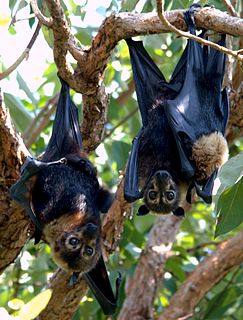
The spectacled flying fox, also known as the spectacled fruit bat, is a megabat that lives in Australia's north-eastern regions of Queensland. It is also found in New Guinea and on the offshore islands including Woodlark Island, Alcester Island, Kiriwina, and Halmahera.
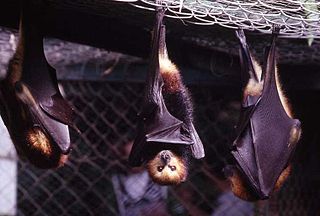
The Mauritian flying fox, also known as Greater Mascarene flying fox or Mauritius fruit bat is a large megabat species endemic to Mauritius and La Réunion.

The hammer-headed bat, also known as hammer-headed fruit bat and big-lipped bat, is a megabat widely distributed in West and Central Africa. It is the only member of the genus Hypsignathus, which is part of the tribe Epomophorini along with four other genera. It is the largest bat in continental Africa, with wingspans approaching 1 m, or about 3 ft, and males almost twice as heavy as females. Males and females also greatly differ in appearance, making it the most sexually dimorphic bat species in the world. These differences include several adaptations that help males produce and amplify vocalizations: the males' larynges are about three times as large as those of females, and they have large resonating chambers on their faces. Females appear more like a typical megabat, with foxlike faces.

The Palawan hornbill is a large forest bird endemic to the Philippines. It is one of the 11 endemic hornbills in the country. It is only found in Palawan and nearby islands of Balabac, Busuanga, Calauit, Culion and Coron. It is locally known as 'talusi' in the language Cuyunon, It is threatened by habitat loss, hunting and trapping for the cage-bird trade.
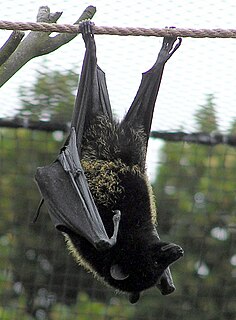
Livingstone's fruit bat, also called the Comoro flying fox, is a megabat in the genus Pteropus. It is an Old World fruit bat found only in the Anjouan and Mohéli islands in the Union of the Comoros in the western Indian Ocean.

The Sulawesi flying fox or Sulawesi fruit bat is a species of megabat endemic to Indonesia. It is classified as "Vulnerable" by the IUCN due to unsustainable levels of hunting.
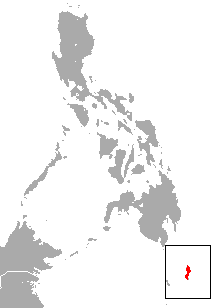
The Talaud flying fox or Talaud fruit bat is a species of bat in the family Pteropodidae. It is endemic to the islands of Salebabu and Karekaleng in the Talaud Archipelago of Indonesia. Its natural habitat is subtropical or tropical swamps.

The Biak naked-backed fruit bat is a species of megabat in the family Pteropodidae. It is endemic to Indonesia.

The straw-coloured fruit bat is a large fruit bat that is the most widely distributed of all the African megabats. It is quite common throughout its area ranging from the southwestern Arabian Peninsula, across forest and savanna zones of sub-Saharan Africa. It is listed as Near Threatened on the IUCN Red List due to a decreasing population trend. Straw-coloured fruit bats travel in massive colonies of at least 100,000 bats and sometimes massing up to 1 million. From October to end of December every year, in the largest migration of mammals on the planet, up to 10 million straw-coloured fruit bats congregate in Kasanka National Park, Zambia, roosting in a 2 hectare area of Mushitu forest each day. This migration was only discovered in 1980. Their necks and backs are a yellowish-brown colour, while their undersides are tawny olive or brownish.

The Peters's epauletted fruit bat is a species of megabat in the family Pteropodidae. It is found in Angola, Botswana, Democratic Republic of the Congo, Malawi, Mozambique, Namibia, Swaziland, Tanzania, Zambia, and Zimbabwe. Its natural habitat is in riverine or evergreen forest, or moist woodland, where there are fruit-bearing trees.

The Ryukyu flying fox or Ryukyu fruit bat is a species of megabat in the family Pteropodidae. It is found in Japan, Taiwan, and the Batanes and Babuyan Islands of the Philippines. Its natural habitats are subtropical or tropical dry forests and subtropical or tropical swamps. It is threatened by habitat loss and by hunting for food and the IUCN classify it as "Vulnerable".
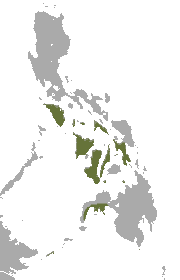
The little golden-mantled flying fox is a species of bat in the family Pteropodidae. It is found in Indonesia and the Philippines. Its natural habitat is subtropical or tropical dry forests. It is threatened by hunting and habitat loss, as well as pollution.

The Madagascan flying fox, Madagascar flying-fox, or Madagascar fruit bat is a species of megabat in the genus Pteropus. It is endemic to Madagascar. Its natural habitat is subtropical or tropical moist lowland forests. It is threatened by habitat loss. It eats figs and other fruits, flowers, and leaves.

The large flying fox, also known as the greater flying fox, Malayan flying fox, Malaysian flying fox, large fruit bat, kalang, or kalong, is a southeast Asian species of megabat in the family Pteropodidae. Despite its scientific name, it feeds exclusively on fruits, nectar, and flowers, like the other flying foxes of the genus Pteropus. It is noted for being one of the largest bats. As with nearly all other Old World fruit bats, it lacks the ability to echolocate but compensates for it with well-developed eyesight.

The Pemba flying fox is a species of flying fox in the family Pteropodidae. It is endemic to the island of Pemba on the coast of Tanzania.

The Halmahera naked-backed fruit bat is a common and widespread species of megabat in the family Pteropodidae. It is endemic to Indonesia. It is assessed as least-concern by the IUCN as it has a wide range and seems to have no significant threats.





















